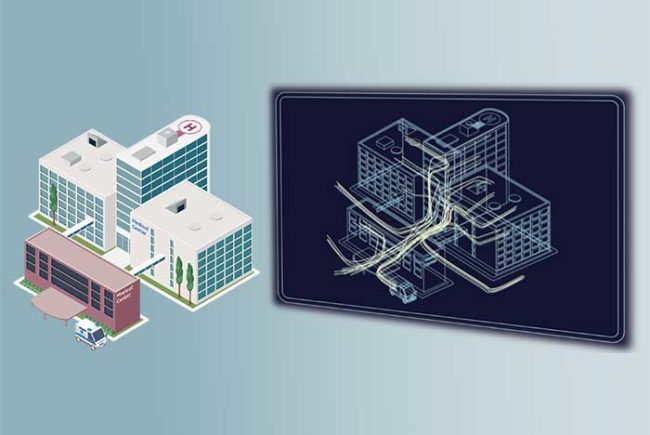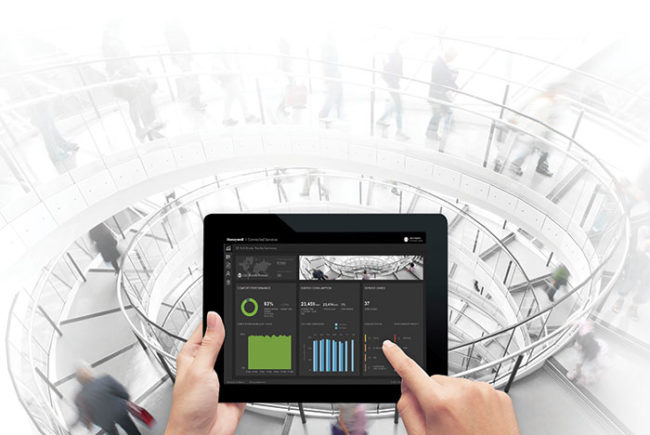
Planning, design and construction challenges during the COVID-19 pandemic have been extensive.
Image by Getty Images
The COVID-19 pandemic has been a major economic and social disruptor, and hospitals have not been spared from this turmoil. People want to stay out of hospitals now more than ever. If they need to be on-site for any reason, they want to feel safe, know they will receive high-quality care and go home in better shape than when they arrived.
As the world continues to learn more about COVID-19 and update processes and procedures to accommodate the changing environment, there is a need to design and construct new spaces and facilities that are as well-equipped as possible for future pandemics.
Flexible plans
The longer COVID-19 sticks around, the more it is viewed as an issue that must be continuously considered. While the hospitalization rate for COVID-19 patients rises and falls, other health care needs remain. Hospitals cannot afford to shut down operations because they need to be available for their communities. They must find ways to flex up to manage patient surges and operationalize these spaces when they aren’t serving COVID-19 patients.
Patient transfers from lower-level facilities have been challenging, as many rural or less-populated areas have been hit hard and beds are scarce for transfers of all conditions. Some rural hospitals even had to close due to challenging financial circumstances and the inability to attract staff and physicians.
Resources
Many are predicting a rise in the acuity of incoming hospital patients. To adapt to this landscape, hospitals are building more flexible intensive care unit (ICU) space, allowing the units to be used for all types of patients with the ability to flex up to an ICU level of care when needed. These units are less efficient from a space perspective and require more expensive infrastructure to support them.
Their HVAC systems require additional air changes, flows and filtration when they are flexed up to be used as ICUs. Staffing shortages and turnover may make it a challenge to keep track of adjusting these spaces back to normal operating procedures when not in use as an ICU. There also is an increased emergency power requirement for the additional equipment needed to care for patients in these spaces.
Patient spaces are being designed to separate COVID-19 patients from the rest of the hospital population. This can add significant space needed to accommodate separate waiting areas, additional donning and doffing stations for personal protective equipment (PPE), and anterooms.
Some of this has been managed during the current pandemic by adjusting entire units to solely serve COVID-19 patients. However, this approach may not be sufficient for future pandemics.
Facilities also installed equipment at the beginning of the pandemic that was intended to be temporary. Many hospitals are consequently looking at making these solutions permanent for future flexibility. While it’s not known what the next pandemic may bring, providing flexibility and infrastructure to support occupants during the next one can be valuable.
Many hospitals are facing not only the challenge of an influx of patients, but also the rising costs to build new or modify their existing spaces. Construction costs have gone up significantly since the pandemic began, and lead times have increased substantially, making the process much less predictable and extending general conditions costs. Hospitals have been forced to keep as many beds operational as possible, in some instances increasing the number of phases in a project or delaying projects to simply allow the rooms to remain occupied.
As future pandemics arise, hospital partnerships with staffing companies, vendors and manufacturers, as well as the architectural, engineering and construction community, will continue to be important because these counterparts can help secure access to equipment and supplies, and leverage regional and national partners for other support.
The cost of construction is one factor; however, COVID-19’s operational impacts also are increasing the cost to operate facilities. There’s added square footage, fewer patients per unit, and more staff and visitor space, coupled with more air changes, increased airflows, additional filter changes and fewer equipment setbacks. This all adds up to more energy usage.
While many health systems have attempted to reduce their energy usage, the measures taken during the current pandemic have moved the dial in the opposite direction. Facility operators are pushing equipment to its maximum in some cases to achieve the needed airflows, thus using more energy, requiring more frequent maintenance and possibly shortening the equipment’s lifespan.
In the future, hospital designs need to adapt to be as efficient as possible while allowing for adjustments in times of need. Flexibility of building systems to operate independently may be more important than ever, in addition to separating units and rooms from each other. Access to the systems for maintenance without having to go into patient care areas could also be vital when maintaining buildings during a pandemic. Staffing challenges continue to be a hurdle, so finding the most efficient way to staff these facilities is a key factor in design.
Providing care to patients in these environments is intense, and as units get larger, the effort required to move from one space to the next increases. Finding solutions to minimize the steps and time needed for such tasks is crucial. Furthermore, clinicians need spaces to take breaks from the demands of work while social distancing from others. The small break rooms of the past may not support these needs going forward, which also may decrease the overall efficiency of these spaces. On-site dining, coffee shops and other places to fully disconnect from care units are important for the well-being of caregivers.
Easing maintenance and cleaning within these spaces can help reduce staffing needs as well as the risk of infection. Cleanable surfaces are more important than ever when ramping up safety protocols. If surface transmission is part of a future pandemic, this will especially hold true. Many facilities have removed carpet and surfaces that are hard to clean to ensure their environmental services departments are able to turn over rooms and clean all public spaces as efficiently and safely as possible.
Replacing old fixtures with touchless fixtures also can reduce the risks. Touchless automatic door operators are being widely installed to further limit direct contact with surfaces, thus reducing cleaning needs. Longer-lasting products that will hold up over time should be used as construction costs increase and the ability to get into patient areas to replace products becomes more challenging. Many durable items had previously been removed from projects due to cost concerns. Facilities should reconsider this approach moving forward.
Technology interactions
Smart rooms, telemedicine integration and virtual care all have found their way into hospitals. These innovations can help improve patient outcomes by reducing staffing needs and potential exposure to infectious diseases (through less people on-site), as well as reducing PPE needs and usage.
Units are being designed and built to offer a mix of nurses taking care of patients both on-site and virtually, allowing staffing ratios to be increased and requiring less in-person staff. There is a balance between on-site needs and the services that can be provided virtually, but this shift has allowed additional flexibility and a more interactive experience for some patients.
Imagine a patient who is too sick to get out of bed to turn on the light or adjust the thermostat in their room. A virtual nurse can assist with these tasks if the room is set up to have those devices controlled remotely. They often can adjust TV stations, order food, assist with education or connect patients with a family member. Clinically, virtual nurses can monitor vital signs and other functions, minimizing potential exposures and enhancing the patient experience. These capabilities are being expanded to other environments, such as the patient’s home, as technology allows for reliable monitoring and preventive checks that used to be accomplished only from a hospital bed.
Such advancements, along with the rising desire of patients to bring their own entertainment devices during hospital stays, adds stress to information technology (IT) infrastructure. While networks must remain protected, allowing patients and visitors to stream their own entertainment is a major patient satisfier. Additional design and construction efforts are needed to accommodate streaming and integrate it properly without overburdening IT networks. A long-term master plan for hospital infrastructure can help provide clarity and upfront planning to support future needs.
Medical records are being integrated much better with patient monitoring, allowing caregivers to take care of patients virtually much more effectively than in the past. However, this model still impacts physical space needs. When physicians are taking care of patients virtually, they need different spaces and technology than they traditionally have worked with. They need spaces where they can be on camera and interact without distractions.
They also may need spaces where they are able to collaborate with other specialists and care team members to ensure they implement the most appropriate care plans. Will these spaces work best if they are on hospital campuses where care teams also provide care to patients in person? Or is it better to be 100% remote? Multiple care methods currently are being tested, and the best option will likely be some combination of both. Additionally, future pandemics will play a role in determining how these models and their physical space needs adjust.
As virtual care becomes more commonplace, technology adoption among patients may differ, and the technology needed to transmit their vitals to care teams may vary. Additionally, Wi-Fi and connectivity required for virtual care and new technologies will be variable across different areas and demographics.
Technologies such as wearable devices, which are being utilized more and more by the public, are continually improving their capabilities. However, they aren’t as accurate as the medical devices used to measure the same functions yet. But, as capabilities improve, the field will have to figure out how to equitably distribute these devices and teach patients how to use them. Training and testing will be a large component of this next stage of at-home virtual care, but the shift will likely have an impact on physical facilities and future care models.
Many procedures are being shifted from large hospital operating rooms to more convenient and efficient ambulatory surgery centers (ASCs). Patients often can access these stand-alone facilities closer to home, which can be more favorable than navigating large hospitals when undergoing routine procedures that don’t necessarily require the infrastructure provided at larger facilities.
ASCs often incorporate clinical services and rehab into their models, integrating the care for those that fit this setting. ASCs also may allow routine procedures for noninfectious patients, secluding infectious patients within hospitals. As a result, ASCs help allow hospital space for the most complex cases, allowing more efficient staffing and bed utilization. It will be important to maintain this care option during any future pandemics.
An often important part of the healing process is the in-person connection that patients have with their loved ones, especially during hospital stays. Therefore, one of the most challenging changes during this pandemic has been the limitation of visitors.
Patients and visitors alike have struggled with not being able to accompany friends and loved ones to hospitals. Patients early in the pandemic were limited to interacting with caregivers adorned with full hazmat PPE as they lay there confused and yearning to see or talk to a familiar face. While this is a drastic example, it encapsulates the reality of this health crisis.
Electronic and other interactions have been used to address this. However, people often struggle to coordinate and synchronize connections when patients are awake or in a position to interact. It will be important to find ways to better accommodate these interactions to improve the healing environment.
Extensive challenges
The challenges for planning, design and construction during a pandemic can be extensive. While the circumstances may change during future pandemics, it will be important to be flexible to adjust to the ever-changing environment and work together as a cohesive team to provide the appropriate level of care for patients.
Suggested changes for PDC projects during a pandemic
It has been challenging to keep planning, design and construction projects on track during the COVID-19 pandemic. Many projects were shut down or put on hold at the beginning of the pandemic, with many eventually resuming and taking advantage of various virtual communication tools, including remote web meetings and virtual walk-throughs.
Staggered in-person site visits and walk-throughs to allow for social distancing and appropriate personal protective equipment (PPE) also have been widely adopted. While these tools, processes and procedures have had varying levels of success, many hospital professionals still see areas for improvement. Some of the following changes may be implemented for future pandemics:
- While virtual meeting technology has allowed out-of-town or off-site personnel to attend, some of the impromptu idea generation that occurs in in-person meetings has been lost. It may be prudent to find appropriate or alternate ways to stage some meetings or gatherings in person, as allowed with applicable PPE.
- Due to patient surges and staffing shortages, hospital personnel needing to attend design meetings are unable because they are occupied with helping patients or providing additional support to colleagues. It may be prudent to stage or schedule meetings at various times throughout the day to give these individuals more flexibility to attend.
- While there are many web-based tools for virtual meetings and for reviewing plans, there are limited capabilities for multiple users to take control of an application (e.g., to point out a change that is needed and potentially draw it on screen rather than verbally describing it). Hopefully, technology partners will devise solutions to address items like this.
Jeremy Bechtold, CHFM, CHC, LEED AP, is vice president of facilities, construction and real estate at Saint Luke’s Health System; and Mark Chrisman, PE, is health sector executive and principal at Henderson Engineers Inc. They can be contacted at jbechtold@saint-lukes.org and mark.chrisman@hendersonengineers.com.
About this article
This is one of a series of monthly articles submitted by members of the American Society for Health Care Engineering’s member tools task force.





